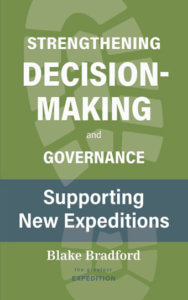Blake Bradford describes how framing meeting agendas around critical questions promotes engagement, innovation, and discernment. Excellent questions focus the power of the group’s gathered wisdom, rather than expecting the group to rubber stamp preformulated plans and solutions.
I know well the admonition from Lovett Weems: “Leaders do not need answers. Leaders must have the right questions.” While this will take one only so far (after all, answers are eventually needed), the statement does reframe the work of leadership. The pastor or the board chair shouldn’t be expected to come to every meeting with a set of answers, ready to unload them at the meeting. Why would you need a board then? Instead, by asking critical questions, the leader can sow seeds of innovation and discernment amongst the board, with the team then formulating the prayerful answers and decisions that can take your congregation toward fulfilling the church’s mission.
In a March 19, 2005, article in the Harvard Business Review titled “How to Design an Agenda for an Effective Meeting,” Roger Schwarz offered an excellent tool for building meeting agendas based entirely on the concept of asking the right questions. The article provides several best practices, but here are a few critical suggestions:
Build your agenda collaboratively.
First, Schwarz recommends leaders collaborate early and ask the team to contribute items and questions that reflect their needs to be engaged in the meeting. I’ve attended too many meetings in which I was a superfluous attendee and not a participant because the agenda only reflected the leader’s needs and not the entire group’s needs. Further, Schwarz suggests that if the chair doesn’t include a requested item, the chair should show accountability to the team member by explaining why it was excluded. It actually might be a teachable moment in that the requested topic is not yet ripe for discussion; maybe it doesn’t fit the steering role of the group; perhaps permission already exists in guiding principles; or the topic is not relevant to the entire board and needs to be handled offline. By explaining why you exclude a request, you are not only showing respect for the board member but helping equip the team for a higher functioning leadership.
Convert agenda topics into action-oriented questions.
The next helpful practice that Roger Schwarz uses is to convert agenda topics into action-oriented questions and include a designation of whether the purpose of the agenda item is to simply update folks with information (which I would suggest belongs in a written report, if possible), seek the group’s input for a leader to make a decision, or if the group is being asked to make a decision or approve an action itself.
Here is the problem that Schwarz is trying to solve: imagine an agenda item that simply says, “Fall Festival.” Just looking at the agenda, some people might be coming to the meeting to argue whether the church can afford it this year, other board members may be wanting to do an evaluation, others thinking a theme is being selected, one is already ordering the pumpkins, and some board members come with suggestions about relocating it to a downtown park location and converting into an evangelism opportunity instead of an insider event.
By writing the item as a question, such as “How can we ensure that the Fall Festival is designed to be a Community Bridge Event to connect with potential guests?” you are setting expectations for the agenda item. Creating the right question also lets Leadership Board members know what is expected of them in the meeting. Schwarz writes, “It’s difficult for team members to participate effectively if they don’t know whether to simply listen, give their input, or be part of the decision-making process. If people think they are involved in making a decision but you simply want their input, everyone is likely to feel frustrated by the end of the conversation.”
Stay on track.
By writing agenda items as questions, you also empower the entire team to help keep the meeting succinct and on track. Team members can police each other by referring to the agenda question when the topic strays from the question at hand. Both of these suggestions take an approach to leadership that is collaborative, and I see this approach as lifting up the power of “the right questions.”
You will note in this meeting model that there is no time set aside for reporting. That is intentional! All reports (including financials) should be sent out in writing a week before the meeting so that precious meeting time is not used up by endless reports of past events that would be better shared in an email.
By starting with the seeds of excellent questions, even in your agenda creation, you are focusing on the power of the group’s gathered wisdom.
 This article is adapted from Strengthening Decision-Making and Governance Supporting New Expeditions (Market Square Books, 2022). Used by permission. The book is also available at Cokesbury and Amazon.
This article is adapted from Strengthening Decision-Making and Governance Supporting New Expeditions (Market Square Books, 2022). Used by permission. The book is also available at Cokesbury and Amazon.
Related Resources
- Right Questions for Church Leaders, a series of Lewis Center e-books, by Lovett H. Weems Jr.
- Keeping Your Meetings from Getting Stuck in the Weeds by Blake Bradford
- 7 Strategies to Master Meetings by Ann A. Michel







